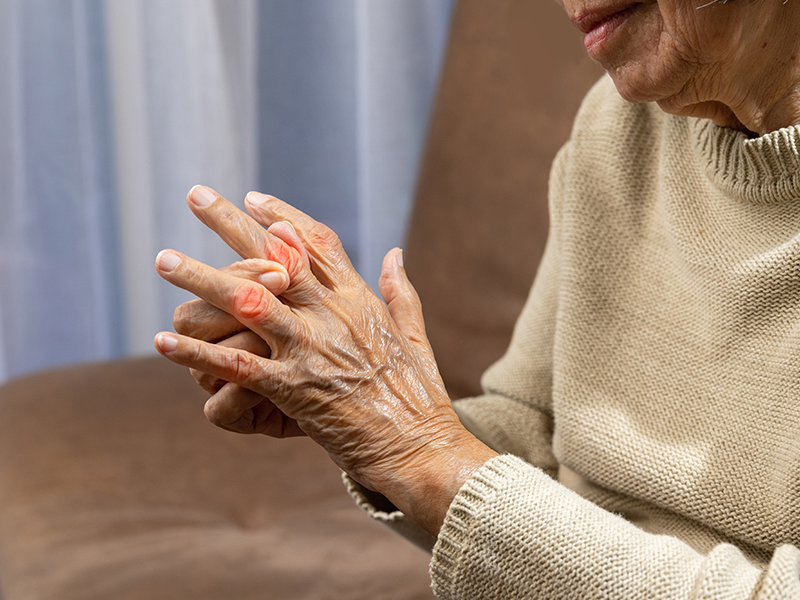Search
Find a Physician
Blog
Nov 22, 2022
While the majority of people are more concerned with rheumatoid arthritis, the truth is that recent studies show that, on average, psoriatic arthritis can be somewhat worse. When compared, the overall pain and fatigue associated with psoriatic arthritis are, on average, slightly worse than those of their rheumatoid counterpart.
Although it may seem harmless, if left untreated for long enough, psoriatic arthritis may permanently damage your joints. For this reason, it is so important that you learn how to recognize early warning signs of psoriatic arthritis and look for professional help right away. To help with this, here’s what some of the first symptoms of psoriatic arthritis may look and feel like.
As a chronic disease, psoriatic arthritis is a disease that will get worse over time. This is why recognizing early symptoms is such an important thing. Now, in many ways, psoriatic arthritis resembles rheumatoid arthritis. For instance, the earliest symptoms are:
So, how can you tell the difference between the two? There are a couple of slight differences worth checking out. First of all, psoriatic arthritis is often asymmetric. So, in the early stages of psoriatic arthritis, it’s not uncommon for only one side of your body to be affected. This doesn’t mean that symmetrical cases are unheard of either.
Perhaps the most recognizable difference is the fact that psoriatic arthritis is, colloquially, often described as “rheumatoid arthritis with a nasty skin rash”. In other words, if, alongside something that feels like rheumatoid arthritis, you also develop a skin condition, chances are that you have one of the early signs of psoriatic arthritis. Psoriasis of the skin is often treated as a separate issue, even though it may have the same origin.
One more thing worth mentioning here is that psoriatic arthritis often causes spondylitis. Simply put, this is inflammation in the joints between your spine and pelvis.
Psoriatic arthritis usually causes swelling of toes and fingers. This condition is also known as dactylitis. Most commonly, it won’t affect all your fingers but one or two at a time. This is one of the early signs of psoriatic arthritis in the hands and it can be incredibly uncomfortable. Small, round dents in fingernails and toenails (as well as toenails that change color) are yet another sign that you might have psoriatic arthritis.
While joint pain, stiffness, and swelling, unfortunately, tend to be known to anyone, how can you tell if they’re caused by psoriatic arthritis and not something else? Well, as we’ve already mentioned, these are often accompanied by a rash. So, that’s one of the first signs that what you’re dealing with might be psoriatic arthritis.
Also, as we’ve already mentioned, the pain is often asymmetric. So, a painful joint in only one knee is also an indicator, albeit not exclusive to psoriatic arthritis.
Most importantly, this is a chronic illness, which means that it won’t hurt (or not equally bad) at all times. There are periods where you don’t feel swelling or pain for days and days. This, however, never lasts indefinitely.
Why a person develops psoriatic arthritis is not always easy to tell. There are several risk factors worth taking into consideration. For instance:
Keep in mind that genetic factors aren’t a guarantee that one will develop psoriatic arthritis. If anything, it’s uncertain what causes psoriatic arthritis. At this stage, our best bet is that it’s a combination of genetic and environmental factors. At the moment, we’re close to discovering genetic markers that are associated with psoriatic arthritis but it’s still not a given thing.
In the introduction, we’ve mentioned that, on average, pain caused by psoriatic arthritis can be more severe. The problem is that about 50% of people never develop an aggressive form of this disease, which makes some physicians overly cautious (they don’t want to over-treat it). Rheumatoid arthritis, for instance, is destructive in most cases, if not treated. While the fact that this is not the case with psoriatic arthritis is a good thing, this also means that early symptoms of psoriatic arthritis often get ignored, even when confirmed.
Another thing worth mentioning is that there’s no cure for psoriatic arthritis. The best you can do is control symptoms and try to prevent joint damage. Your best bet at achieving this lies in looking for an experienced psoriatic arthritis rheumatologist. Without the right treatment, even a risk as high as disability is not off the table.
After you get your psoriatic arthritis diagnosis, the treatment will usually involve various methods to control inflammation. So, several anti-inflammatory drugs, both steroidal and non-steroidal will be used. Other than this, biological agents like DMARDs (disease-modifying antirheumatic drugs) are also in use.
Most importantly, an alteration of your lifestyle will be needed. You see, the biggest problems that you’ll have are inflammatory, which is why avoiding foods that cause inflammation might be best avoided. So, stay clear of:
Specialized prevention or treatment diets can make a world of difference and they’re not to be taken for granted.
In the end, the fact that swelling is the main symptom of psoriatic arthritis makes it so difficult to diagnose. After all, swelling is a common symptom of many different illnesses. One thing that separates psoriatic arthritis from its rheumatoid counterpart is usually the rash that accompanies its other symptoms. When ignored for long enough, psoriatic arthritis has the potential to cause quite a bit of pain and discomfort. This is why it’s so important to take early warning signs of psoriatic arthritis seriously.
For those who want a professional opinion and diagnosis, talking to a rheumatologist in NJ might be the best course of action.
This article was reviewed and approved by an orthopedic surgeon as we place a high premium on accuracy for our patients and potential patients.